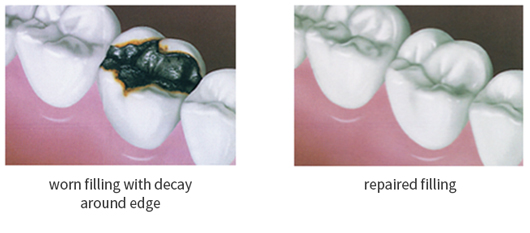

Dental Fillings in Minneapolis
Tooth-colored and Silver Fillings
When teeth are affected by cavities caused by decay (caries), the decayed areas of the tooth can be removed and replaced by fillings, provided the decay has not progressed too far. The fillings come in two basic materials; tooth-colored composites or ‘silver’ fillings.
Tooth-colored fillings
Tooth-colored fillings usually consist of a composite material made up of acrylic resin, quartz (to resist wear) and colorants to match the natural color of the tooth. Fillings made with these composites bond well to the internal surfaces of the tooth, which enhances the strength of the filling. In addition, they are usually unnoticeable due to excellent color matching with the natural tooth. Composite fillings also require less drilling and preserve more of the original tooth, because silver fillings require a certain size to resist breaking or falling out.
Silver Fillings
‘Silver’ fillings, also called amalgam, in fact consist of a mixture of silver, tin, copper, and mercury. Silver fillings have been used in dentistry for over 100 years with good results. While mercury in itself may be harmful, many studies have shown that very little is released from the amalgam in fillings.
Silver fillings are often less expensive than composite fillings and some insurance policies may not cover that additional cost of composite fillings. Silver fillings are more noticeable due to their darker color.
Which should I choose?
Tooth-colored composite fillings are superior in most applications to silver fillings, but they might be more expensive than silver fillings. For these reasons, we typically recommend the use of composites for all fillings. Composites are always recommended to fill the more noticeable front teeth to protect the appearance of your smile. In rare occasions, silver filings might be used toward the rear of the mouth, where they are less visible. We will discuss the advantages and disadvantages of each type of filling with you, if and when one or more is required. As always, a natural healthy tooth is preferable to repair work, and our primary task is to help you avoid the necessity of fillings altogether!
Filling Replacement
There is no perfect substitute for a natural, healthy tooth. A tooth that has decay will need treatment with a dental filling or other restoration depending on the extent of the decay.
A dental filling may last many years before it needs replacing. However, fillings are subject to constant stress from chewing. Clenching or grinding teeth also puts tremendous force on fillings and tooth enamel. All of these can cause a filling to gradually wear away, chip, crack or fall out.

Regular dental examinations are important because problems with existing fillings generally can be detected in the early stage. During your checkup, we can determine whether existing fillings are intact, or if any have cracked or worn away. Worn fillings should be replaced promptly. Don’t wait until the tooth hurts or the filling and the tooth crack. This can complicate treatment and make it more costly.
It is particularly important that teeth with fillings be kept in good health with regular dental visits and professional teeth cleanings. If extensive tooth decay develops around an existing filling, little tooth structure may be left once the decay is removed. Your dentist may need to restore the tooth with a crown instead of another filling.
Our services include:
- white (composite) fillings vs silver (amalgam) fillings
- bondings (white, composite)

